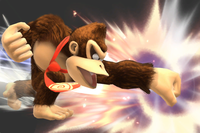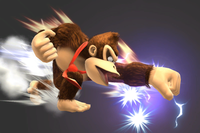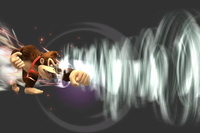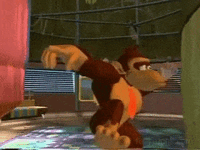Giant Punch
| Giant Punch | |
|---|---|
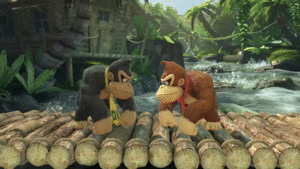 Giant Punch in Super Smash Bros. Ultimate. | |
| User | Donkey Kong |
| Universe | Donkey Kong |
Giant Punch (ジャイアントパンチ, Giant Punch) is Donkey Kong's neutral special move.
Overview[edit]
By pressing the special move button, Donkey Kong will start swinging his arm around, automatically charging a wind-up punch that, when thrown, causes great damage and knockback if it hits, especially when fully or nearly-fully charged. Throughout the Super Smash Bros. series, the Giant Punch has consistently been one of the most powerful special attacks.
For every time that Donkey Kong swings his fist, the charge advances to its next stage, entailing an increase in the damage of the punch. After any one of these swings, the charge can be cancelled and stored to be continued later: by pressing the shield button while charging, Donkey Kong will shield, and moving the control stick left or right will cause him to roll. If Donkey Kong suffers knockback while charging, he will lose all of his charge.
At any time while Donkey Kong is swinging his fist around, the button can be pressed again to deliver the blow. If the button is not pressed, then after ten swings, Donkey Kong will drop his fist and, as of Melee, his head will begin to smoke, indicating the punch is fully charged; in Smash 64 this is instead signaled by his fist sparking. At this point the button only needs to be pressed once to administer the attack.
A Giant Punch that has just one stage below full charge has noticeably higher knockback. In Melee, the move is also stronger if unleashed immediately after charging, rather than being stored.
From Brawl onwards, a fully charged Giant Punch grants Donkey Kong armor when used, allowing him to power through an enemy's KO attack while he uses one of his own in the process.
From Melee onwards, the move becomes markedly weaker if used in midair, and also causes Donkey Kong to become helpless (this is no longer the case in Ultimate), making it very risky and much less rewarding to use in aerial combat compared to its utility on the ground. Starting from Melee, a fully-charged punch is also performed significantly faster than ones that aren't fully charged, incentivizing Donkey Kong to fully charge the move.
Aesthetically, the move has been through a few changes. In Smash 64, Donkey Kong has his right hand directly behind him while his fist winds up. As of Melee, Donkey Kong uses his left arm for the attack, while also winding up his arm beside himself. The move was the slowest in Smash 64 with some notable recovery, though the animation for both the actual attack's startup and its recovery has been sped up in later games. In Ultimate, Donkey Kong now charges Giant Punch with either arm, due to his mirrored stance. It also no longer puts him into a helpless state, similar to Smash 64. After fully charging his Giant Punch, Donkey Kong now displays an angry expression until he unleashes his Giant Punch, though he shows a regular expression by canceling Giant Punch with a shield button just as it is about to get fully charged. This expression notably (and strangely in some cases, like being buried) overrides most expressions he'd normally make performing actions.
Stages[edit]
As explained above, Giant Punch's charge goes through stages. These are visually recorded in the swings of Donkey Kong's arm; each time he swings, the punch's damage and knockback is generally increased. The charge has eleven stages in total; the eleventh stage is the fully charged stage. A fully charged Giant Punch will have a quicker animation, resulting in a quicker punch, and do the most damage, but is weaker in knockback than a few of the stages below it. From Melee onwards, all stages of the punch are weaker when used in mid-air.
Smash 64 stages[edit]
| Stage | Number of swings | Damage | Percent that can KO | Elbow damage | Elbow percent that can KO |
|---|---|---|---|---|---|
| Stage 1 | 1 | 14% | |||
| Stage 2 | 2 | 16% | |||
| Stage 3 | 3 | 18% | |||
| Stage 4 | 4 | 20% | |||
| Stage 5 | 5 | 22% | |||
| Stage 6 | 6 | 23% | |||
| Stage 7 | 7 | 26% | |||
| Stage 8 | 8 | 28% | |||
| Stage 9 | 9 | 30% | 65% | ||
| Stage 10 | 10 | 32% | 50% | 31% | |
| Stage 11 | 11 | 36% | 48% | 35% |
Brawl stages[edit]
| Stage | Number of swings | Damage | Percent that can KO | Elbow damage | Elbow percent that can KO |
|---|---|---|---|---|---|
| Stage 1 | 1 | 10% | 178% | 12% | 146% |
| Stage 2 | 2 | 12% | 150% | 14% | 124% |
| Stage 3 | 3 | 14% | 126% | 16% | 107% |
| Stage 4 | 4 | 16% | 110% | 18% | 93% |
| Stage 5 | 5 | 18% | 95% | 20% | 81% |
| Stage 6 | 6 | 20% | 83% | 22% | 70% |
| Stage 7 | 7 | 22% | 72% | 24% | 61% |
| Stage 8 | 8 | 24% | 63% | 26% | 53% |
| Stage 9 | 9 | 26% | 55% | 28% | 46% |
| Stage 10 | 10 | 28% | 48% | 30% | 39% |
| Stage 11 | 11 | 28% | 72% | 18% | 101% |
| Aerial stage 1 | 1 | 6% | 276% | 8% | 213% |
| Aerial stage 2 | 2 | 8% | 218% | 10% | 174% |
| Aerial stage 3 | 3 | 10% | 178% | 12% | 146% |
| Aerial stage 4 | 4 | 12% | 150% | 14% | 124% |
| Aerial stage 5 | 5 | 14% | 126% | 16% | 107% |
| Aerial stage 6 | 6 | 16% | 110% | 18% | 93% |
| Aerial stage 7 | 7 | 18% | 95% | 20% | 81% |
| Aerial stage 8 | 8 | 20% | 83% | 22% | 70% |
| Aerial stage 9 | 9 | 22% | 72% | 24% | 61% |
| Aerial stage 10 | 10 | 24% | 63% | 26% | 53% |
| Aerial stage 11 | 11 | 25% | 86% | 15% | 125% |
- Note that not only does a stage ten Giant Punch have more knockback than a fully charged punch, but stages eight and nine also have more knockback.
- The sweetspot for an uncharged Giant Punch is at the elbow.
A video showcasing all the stages of Brawl's Giant Punch.
SSB4 stages[edit]
| Stage | Number of swings | Damage | Percent that can KO | Elbow damage | Elbow percent that can KO |
|---|---|---|---|---|---|
| Stage 1 | 1 | 10% | 183% | 12% | 146% |
| Stage 2 | 2 | 12% | 153% | 14% | 125% |
| Stage 3 | 3 | 14% | 131% | 16% | 107% |
| Stage 4 | 4 | 16% | 113% | 18% | 93% |
| Stage 5 | 5 | 18% | 98% | 20% | 81% |
| Stage 6 | 6 | 20% | 85% | 22% | 71% |
| Stage 7 | 7 | 22% | 75% | 24% | 62% |
| Stage 8 | 8 | 24% | 65% | 26% | 53% |
| Stage 9 | 9 | 26% | 57% | 28% | 46% |
| Stage 10 | 10 | 28% | 49% | 30% | 40% |
| Stage 11 | 11 | 28% | 74% | 18% | 234% |
| Aerial stage 1 | 1 | 6% | 284% | 8% | 214% |
| Aerial stage 2 | 2 | 8% | 223% | 10% | 175% |
| Aerial stage 3 | 3 | 10% | 183% | 12% | 146% |
| Aerial stage 4 | 4 | 12% | 153% | 14% | 125% |
| Aerial stage 5 | 5 | 14% | 131% | 16% | 107% |
| Aerial stage 6 | 6 | 16% | 113% | 18% | 93% |
| Aerial stage 7 | 7 | 18% | 98% | 20% | 81% |
| Aerial stage 8 | 8 | 20% | 85% | 22% | 71% |
| Aerial stage 9 | 9 | 22% | 75% | 24% | 62% |
| Aerial stage 10 | 10 | 24% | 65% | 26% | 53% |
| Aerial stage 11 | 11 | 25% | 88% | 15% | 126% |
Ultimate[edit]
Ultimate abandoned the concept of storing Giant Punch in stages, instead opting for a charge formula in line with other moves. In this case, Giant Punch's power will increase by a given amount every 6.67 Frames. The charge duration lasts 110 Frames as of 6.0.0, and overall it will increase in power by 18%.[1] This means it will deal 28% maximum. As usual, an uncharged Giant Punch is more powerful than a maximum charged one. However, to utilize this takes extreme precision in Ultimate due to its frame perfect nature and no longer charging via windups.
Charging from nothing to full takes 121 frames, including the 7 frame pre-charge lag and 4 frame post-charge lag (which can also be applied to shielding, rolling or jumping). It can also be cancelled through jumping in the air, which takes 5 frames as well.
Ultimate introduced a glitch that caused the Z-Axis to make Giant Punch miss point-blank opponents. This was fixed in 3.0.0, although only for the fully charged version.[2][3] 3.1.0 fixed a glitch with Giant Punch that existed since Smash 4, where landing on frames 12-17 during a fully charged Giant Punch caused DK to never get his super armor.[4]
Reverse charge cancelling[edit]
Reverse charge cancelling is the concept of reversing Giant Punch's windups, and has existed since 64,[5] and stayed in every Smash game to date. Normally it is impossible to B-reverse the windups, but through inputting a normal turnaround B, this can occur. This provides some additional unique maneuvers for Donkey Kong, especially in later games where charge cancelling becomes more prominent.
Since Melee added the ability to cancel Giant Punch in the air,[6] it became possible for Donkey Kong to use reverse charge cancelling for movement. Through this, he could reverse charge cancel, cancel the Giant Punch windups, and follow up with an aerial. This added many of the options high-level players still use today, such as the ledge options it provided. RCC back aerial was a powerful way to avoid ledgetraps. The ability to use reverse aerial rushes through this added powerful mixup options as well, adding further depth to Donkey Kong's playstyle. It's also possible to chain these together, possibly allowing for a powerful punish if the opponent tries to jump in. This gives Donkey Kong better bait and punish tactics that would otherwise be very difficult to do.
In Ultimate, the ability to jump cancel charge moves greatly improved reverse charge cancelling .[7] This made reverse charge cancelling much more accessible to players, not having to simply cancel Giant Punch and then jump. This greatly streamlines Donkey Kong's playstyle. It also provides Donkey Kong with an extra movement option, as the momentum allows for him to weave in and out of the opponent's range, especially with the ability to jump now readily available and not requiring more frames to cancel Giant Punch.
Instructional quotes[edit]
| Press | ||
| Charge with B, then press again to punch. Quit charging with Z. | ||
| Charge with | ||
| Charges up a punch that can keep charging after dodging or shielding. |
Customization[edit]
Special Move customization was added in Super Smash Bros. 4. These are the variations:
- Giant Punch: Default.
- Lightning Punch: An electric punch that charges up much faster, but is weaker and doesn't have flinch resistance. Deals 15% damage at full charge and the move has slightly less startup than Giant Punch.
- Storm Punch: Less powerful, but charges faster and generates a whirlwind that blows opponents away. The whirlwind itself is enough to send opponents flying off-stage at high percentages, if not also KO them by sending them towards the side blastline. The move does 18% damage.
Origin[edit]
While the move has no true origin from his home series, Donkey Kong has done a similar punch to this in other forms of media outside of Smash Bros.: Donkey Kong performs a punch comparable to the Giant Punch in the Donkey Kong Country episode "Bad Hair Day; when players land on a Bowser Space in Mario Party 5, Donkey Kong may appear and punch Bowser in a similar way to the Giant Punch; in the ending of Donkey Kong Country Returns, Donkey Kong throws a punch similar to this when he is about to strike the moon to destroy the Tiki Tong Tower with it; in Donkey Kong Bananza, Donkey Kong can temporarily transform into a stronger, beastly form called "Kong Bananza", which allows him to throw wind-up punches that sends shockwaves in a similar fashion to Giant Punch.
The move could also be based on Gigaton Punch from the Tekken series, sporting a very similar name, animation and gameplay purpose.
Gallery[edit]
Charging a Giant Punch in Super Smash Bros.
Giant Punch in Melee.
Donkey Kong using the Giant Punch on Ike in Brawl.
Donkey Kong using the Giant Punch on Samus in Super Smash Bros. for Wii U.
Names in other languages[edit]
Technical details[edit]
- Donkey Kong (SSB)/Neutral special
- Donkey Kong (SSBM)/Neutral special
- Donkey Kong (SSBB)/Neutral special
- Donkey Kong (SSB4)/Neutral special
- Donkey Kong (SSBU)/Neutral special
References[edit]
- ^ https://docs.google.com/spreadsheets/d/1rwDPL1jhE-KuEbbcBkkTb44z1smJp9rYme_xb4BIJTk/edit#gid=1250248030 vl param sheet shows 18% is the added power.
- ^ https://youtu.be/_l4JQY9BDu4
- ^ https://streamable.com/i9kve
- ^ https://www.kotaku.com.au/2019/03/smash-players-are-begging-nintendo-to-fix-donkey-kongs-giant-punch/
- ^ https://www.youtube.com/watch?v=F6CtAKRTjXQ
- ^ https://youtu.be/s0FPgLifo_Q
- ^ https://www.youtube.com/watch?v=ixQ7axGsjJo

